Mechanical Characterisation of Gypsum-Based Passive Fire Protection Mortars with Micro and Nano Silica Particles
Abstract
:1. Introduction
2. Materials and Methods
2.1. Materials and Compositions
2.2. Experimental Programme
2.3. Preparation of the Specimens
- The raw materials were weighed and placed inside a mixer container.
- Then, the mixer was operated for 5 min at a slow speed (136 rotations per minute). At the same time, the corresponding amount of water was added with a constant flow rate to guarantee the homogeneous addition of water to the whole mortar. Previously, the NMS activation was required. For this purpose, 2.4 g of NMS particles were placed in a 45 millilitres water solution and subjected to ultrasounds for twelve hours using Retsh equipment.
- After this procedure, the mortar was manually kneaded with a spatula to remove parts of the mortar that were on the walls of the container and thus homogenise the mixture, which was then returned to the container for another 2 min.
- The mortar was then placed inside the mould.
2.4. Experimental Testing System and Procedure
2.4.1. Complementary Tests
Density and Porosity Measurements
Thermogravimetric Analysis (TGA)
X-ray Diffraction (XRD) and Scanning Electron Microscopy (SEM)
2.4.2. Non-Destructive Tests
Ultrasonic Pulse Velocity Test
Impulse Excitation of Vibration Test
2.4.3. Destructive Tests
Flexural Test
Compression Test
3. Results and Discussion
3.1. Complementary Tests
3.2. Non-Destructive Tests
3.2.1. Ultrasonic Pulse Velocity Test
3.2.2. Impulse Excitation of Vibration Test
3.2.3. Discussion of the Tests Results
3.3. Destructive Tests
3.3.1. Flexural Test
3.3.2. Compression Test
3.3.3. Discussion of the Test Results
4. Conclusions
- -
- Non-destructive testing revealed that the developed mortars exhibited uniform and homogeneous matrices;
- -
- It was observed that higher binder dosages and lower aggregate dosages led to increased velocities/frequencies in non-destructive tests, correlating with higher mechanical strength and improved physical properties;
- -
- The addition of short amounts of nano and micro silica particles in the mortars posed challenges to the mechanical and physical properties of such mortars;
- -
- Compositions incorporating vermiculite demonstrated superior or comparable mechanical properties to the commercial composition, underscoring the potential for innovative material formulations. Conversely, compositions featuring perlite exhibited slightly lower mechanical properties compared to the commercial variant, yet this observation presents an opportunity for further optimisation;
- -
- Notably, the study found a strong correlation between the mechanical properties studied (flexural and compression strength) and the physical properties (Young’s modulus of elasticity and shear modulus) of the developed mortars, indicating robust material performance;
- -
- These insights highlight the potential for continued advancements in mortar development for enhanced fire protection, paving the way for more resilient and reliable construction materials in the future.
Author Contributions
Funding
Institutional Review Board Statement
Informed Consent Statement
Data Availability Statement
Acknowledgments
Conflicts of Interest
Abbreviations
| B | Binder |
| C | Commercial passive protection composition used as reference mortar |
| CPPS | Commercial passive protection solution |
| CP | Compression |
| Ca2+ | Calcium ion |
| CaCO3 | Calcium carbonate (calcite) |
| CaSO4 | Calcium sulphate (anhydrite) |
| CaSO4·2H2O | Calcium sulphate dihydrate (Gypsum) |
| CaSO4·1/2H2O | Calcium sulphate hemihydrate |
| C-S-H | Calcium silicate hydrate |
| CO2 | Carbon dioxide |
| E | Young’s modulus |
| EP | Expanded perlite |
| EV | Expanded vermiculite |
| FL | Flexural |
| G | Shear modulus |
| GP | Gypsum powder |
| IEV | Impulse excitation of vibration |
| MS | Micro particles of silica |
| nano-Al2O3 | Aluminium Oxide Nanoparticles |
| nano-Fe2O3 | Iron Oxide Nanoparticles |
| nano-SiO2 | Silicon Oxide Nanoparticles |
| NMS | Nano and micro particles of silica |
| NS | Nano particles of silica |
| P | Developed gypsum mortar with perlite |
| P.NMS | Developed gypsum mortar with perlite, nano and micro silica particles |
| SD | Standard deviation |
| SEM | Scanning electron microscopy |
| SiO2 | Silicon dioxide |
| TGA | Thermo gravimetric analysis |
| UPV | Ultrasonic pulse velocity |
| V | Developed gypsum mortar with vermiculite |
| V/B | Vermiculite to binder ratio |
| V.NMS | Developed gypsum mortar with vermiculite, nano and micro silica particles |
| W | Water |
| W/GP | Water gypsum ratio in weight % |
| XRD | X-ray diffraction |
| Notation | |
| ρ | Density |
| μ | Poisson’s ratio |
| fct,c | Compression strength |
| fct,fl | Flexural strength |
| ff | Fundamental resonant frequency of bar in flexure |
| ft | Fundamental resonant frequency of bar in torsion |
| Vp | Pulse-propagation velocity of the compression wave |
| Vs | Pulse-propagation velocity of the shear wave |
References
- Eckelman, M.J.; Brown, C.; Troup, L.N.; Wang, L.; Webster, M.D.; Hajjar, J.F. Life cycle energy and environmental benefits of novel design-for-deconstruction structural systems in steel buildings. Build. Environ. 2018, 143, 421–430. [Google Scholar] [CrossRef]
- Shi, G.; Ban, H.; Shi, Y.; Wang, Y. Overview of research progress for high strength steel structures. Eng. Mech. 2012, 30, 1–13. [Google Scholar] [CrossRef]
- Gervásio, H.; Simões da Silva, L. A Sustentabilidade do aço, Construção Metálica e Mista V; CMM: Lisboa, Portugal, 2005; pp. 719–730. [Google Scholar]
- Santiago, A.; Simões da Silva, L.; Vaz, G.; Vila Real, P.; Gameiro Lopes, A. Experimental investigation of the behaviour of a steel sub-frame under a natural fire. Int. J. Steel Compos. Struct. 2008, 8, 243–264. [Google Scholar] [CrossRef]
- Ryou, J.; Kim, H. New approach for delaying the internal temperature rise of fire resistant mortar made with coated aggregate. Constr. Build. Mater. 2017, 149, 76–90. [Google Scholar] [CrossRef]
- Couto, C.; Real, P.V. The influence of imperfections in the critical temperature of I-section steel members. J. Constr. Steel Res. 2021, 179, 106540. [Google Scholar] [CrossRef]
- Laím, L.; Santiago, A.; Caetano, H.; Craveiro, H.D.; Shahbazian, A. Numerical analysis and structural fire design of protected SHS steel columns with thermally enhanced gypsum-based mortars. J. Build. Eng. 2022, 54, 104629. [Google Scholar] [CrossRef]
- EN 1993-1-2-2005; Eurocode 3: Design of Steel Structures. Part 1.2: General Rules—Structural Fire Design. European Committee for Standardization (CEN): Brussels, Belgium, 2005.
- Caetano, H.; Laím, L.; Santiago, A.; Durães, L.; Shahbazian, A. Development of Passive Fire Protection Mortars. Appl. Sci. 2022, 12, 2093. [Google Scholar] [CrossRef]
- Mo, K.H.; Lee, H.J.; Liu, M.Y.J.; Ling, T. Incorporation of expanded vermiculite lightweight aggregate in cement mortar. Constr. Build. Mater. 2018, 179, 302–306. [Google Scholar] [CrossRef]
- Laím, L.; Caetano, H.; Santiago, A. Review: Effects of nanoparticles in cementitious construction materials at ambient and high temperatures. J. Build. Eng. 2021, 35, 102008. [Google Scholar] [CrossRef]
- Nuaklong, P.; Boonchoo, N.; Jongvivatsakul, P.; Charinpanitkul, T.; Sukontasukkul, P. Hybrid effect of carbon nanotubes and polypropylene fibres on mechanical properties and fire resistance of cement mortar. Constr. Build. Mater. 2020, 275, 122189. [Google Scholar] [CrossRef]
- Irshidat, M.; Al-Saleh, M.H. Thermal performance and fire resistance of nanoclay modified cementitious materials. Constr. Build. Mater. 2017, 159, 213–219. [Google Scholar] [CrossRef]
- Gomes, M.G.; Flores-Colen, I.; Pedroso, M. Thermal conductivity measurement of thermal insulating mortars with EPS and silica aerogel by steady-state and transient methods. Constr. Build. Mater. 2018, 172, 696–705. [Google Scholar] [CrossRef]
- Farzadnia, N.; Ali, A.A.A.; Demirboga, R.; Anwar, M.P. Effect of halloysite nanoclay on mechanical properties, thermal behaviour and microstructure of cement mortars. Cem. Concr. Res. 2013, 48, 97–104. [Google Scholar] [CrossRef]
- Oltulu, M.; Şahin, R. Effect of nano-SiO2, nano-Al2O3 and nano-Fe2O3 powders on compressive strengths and capillary water absorption of cement mortar containing fly ash: A comparative study. Energy Build. 2012, 58, 292–301. [Google Scholar] [CrossRef]
- Köksal, F.; Serrano-López, M.A.; Şahin, M.; Gencel, O.; López-Colina, C. Combined effect of steel fibre and expanded vermiculite on properties of lightweight mortar at elevated temperatures. Mater. Struct. 2015, 48, 2083–2092. [Google Scholar] [CrossRef]
- Köksal, F.; Gencel, O.; Kaya, M. Combined effect of silica fume and expanded vermiculite on properties of lightweight mortars at ambient and elevated temperatures. Constr. Build. Mater. 2015, 88, 175–187. [Google Scholar] [CrossRef]
- Gencel, O.; Gholampour, A.; Tokay, H.; Ozbakkaloglu, T. Replacement of Natural Sand with Expanded Vermiculite in Fly Ash-Based Geopolymer Mortars. Appl. Sci. 2021, 11, 1917. [Google Scholar] [CrossRef]
- Hasanabadi, S.; Sadrameli, S.M.; Sami, S. Preparation, characterisation and thermal properties of surface modifed expanded perlite/paraffin as a form stable phase change composite in concrete. J. Therm. Anal. Calorim. 2021, 144, 61–69. [Google Scholar] [CrossRef]
- Santos, T.; Gomes, M.I.; Silva, A.S.; Ferraz, E.; Faria, P. Comparison of mineralogical, mechanical and hygroscopic characteristic of earthen, gypsum and cement-based plasters. Constr. Build. Mater. 2020, 254, 119222. [Google Scholar] [CrossRef]
- Babu, K.S.; Ratnam, C. Mechanical and thermophysical behaviour of hemp fibre reinforced gypsum composites. Mater. Today Proc. 2020, 44, 2245–2249. [Google Scholar] [CrossRef]
- Mayo-Corrochano, C.; Sánchez-Aparicio, L.J.; Aira, J.; Sanz-Arauz, D.; Moreno, E.; Melo, J.P. Assessment of the elastic properties of high-fired gypsum using the digital image correlation method. Constr. Build. Mater. 2022, 317, 125945. [Google Scholar] [CrossRef]
- Rahmanian, I. Thermal and Mechanical Properties of Gypsum Boards and Their Influences on Fire Resistance of Gypsum Board Based Systems. Ph.D. Thesis, University of Manchester, Manchester, UK, 2011. [Google Scholar]
- Vaz-Ramos, J.; Santiago, A.; Portugal, A.; Durães, L. Synthesis of silica nanoparticles to enhance the fire resistance of cement mortars. Fire Res. 2019, 3, 44–48. [Google Scholar] [CrossRef]
- EN 12390-5; Testing Hardened Concrete. Part 5: Flexural Strength of Test Specimens. European Committee for Standardization (CEN): Brussels, Belgium, 2019.
- EN 1015; Methods of Test for Mortar for Masonry. Part 11: Determination of Flexural and Compressive Strength of Hardened Mortar. European Committee for Standardization (CEN): Brussels, Belgium, 2020.
- ASTM C20-00; Standard Test Methods for Apparent Porosity, Water Absorption, Apparent Specific Gravity, and Bulk Density of Burned Refractory Brick and Shapes by Boiling Water. ASTM International: West Conshohocken, PA, USA, 2020.
- ISO/DIS 15901-1; Evaluation of Pore Size Distribution and Porosity of Solid Materials by Mercury Porosimetry and Gas Adsorption, Part 1: Mercury Porosimetry. International Organization for Standardization (ISO): Geneva, Switzerland, 2014.
- ASTM D 2845-05; Standard Test Method for Laboratory Determination of Pulse Velocities and Ultrasonic Elastic Constants of Rock. ASTM International: West Conshohocken, PA, USA, 2005.
- ASTM E 1876-01; Standard Test Method for Dynamic Young’s Modulus, Shear Modulus, and Poisson’s Ratio by Impulse Excitation of Vibration. ASTM International: West Conshohocken, PA, USA, 2002.
- Ugarte, J.F.O.; Sampaio, J.A.; França, S.C.A. Chapter 38: Vermiculite. In Industrial Rocks and Minerals, 2nd ed.; CETEM: Yecla, Spain, 2008. [Google Scholar]
- Filho, S.H.S.; Vinaches, P.; Pergher, S.B.C. Structural characterisation of expanded perlite. Perspect. Erechim 2017, 41, 81–87. [Google Scholar]
- He, R.; Lu, N. Hydration, fresh, mechanical, and freeze-thaw properties of cement mortar incorporated with polymeric microspheres. Adv. Compos. Hybrid Mater. 2024, 7, 92. [Google Scholar] [CrossRef]
- Luo, D.; Zhou, M.; Li, F.; Niu, D. Chloride ion transport in coral aggregate concrete subjected to coupled erosion by sulfate and chloride salts in drying-wetting cycles. J. Mater. Res. Technol. 2024, 30, 3251–3267. [Google Scholar] [CrossRef]
- He, R.; Nantung, T.; Olek, J.; Lu, N. Field study of the dielectric constant of concrete: A parameter less sensitive to environmental variations than electrical resistivity. J. Build. Eng. 2023, 74, 106938. [Google Scholar] [CrossRef]
- Kondratieva, N.; Barre, M.; Goutenoire, F.; Sanytsky, M. Study of modified gypsum binder. Constr. Build. Mater. 2017, 149, 535–542. [Google Scholar] [CrossRef]
- Azdarpour, A.; Karaei, M.A.; Hamidi, H.; Mohammadian, E.; Honarvar, B. CO2 sequestration through direct aqueous mineral carbonation of red gypsum. Petroleum 2018, 4, 398–407. [Google Scholar] [CrossRef]
- Essabir, H.; Raji, M.; Nekhlaoui, S.; Hassani, I.A.; Essassi, M.; Rodrigue, D.; Bouhfid, R.; Qaiss, A. Utilisation of volcanic amorphous aluminosilicate rocks (perlite) as alternative materials in lightweight composites. Compos. Part B 2019, 165, 47–54. [Google Scholar] [CrossRef]
- Mucahit, S. Influence of expanded vermiculite on physical properties and thermal conductivity of clay bricks. Ceram. Int. 2014, 41, 2819–2827. [Google Scholar] [CrossRef]
- ElNemr, A. Generating water/binder ratio -to- strength curves for cement mortar used in Masonry walls. Constr. Build. Mater. 2020, 233, 117249. [Google Scholar] [CrossRef]
- Cabuk, M.; Yesil, T.A.; Yavuz, M.; Unal, H.I. Colloidal and viscoelastic properties of expanded perlite dispersions. J. Intell. Mater. Syst. Struct. 2018, 29, 32–40. [Google Scholar] [CrossRef]
- Wang, Z.; Xia, Z. Rigid polyurethane/expanded vermiculite/ melamine phenyl phosphate composite foams with good flame retardant and mechanical properties. e-Polymers 2019, 19, 563–573. [Google Scholar] [CrossRef]
- Oliveira, M. Study of the Degradation of 18th Century Alabaster Sculptures through Accelerated Aging on Test Samples; CeROArt: Micheroux, Belgium, 2022. [Google Scholar] [CrossRef]
- Wang, L.; Jin, M.; Guo, F.; Wang, Y.; Tang, S. Pore Structural and Fractal Analysis of the Influence of Fly Ash and Silica Fume on the Mechanical Property and Abrasion Resistance of Concrete. Fractals 2021, 29, 2140003. [Google Scholar] [CrossRef]
- Wang, L.; Jin, M.; Wu, Y.; Zhou, Y.; Tang, S. Hydration, shrinkage, pore structure and fractal dimension of silica fume modified low heat Portland cement-based materials. Constr. Build. Mater. 2021, 272, 121952. [Google Scholar] [CrossRef]
- Liao, Y.; Wang, S.; Wang, K.; Al Qunaynah, S.; Wan, S.; Yuan, Z.; Xu, P.; Tang, S. A study on the hydration of calcium aluminate cement pastes containing silica fume using non-contact electrical resistivity measurement. J. Mater. Res. Technol. 2023, 24, 8135–8149. [Google Scholar] [CrossRef]
- EN 13279-1; Gypsum Binders and Gypsum Plasters. Part 1: Definitions and Requirements. European Committee for Standardization (CEN): Brussels, Belgium, 2005.
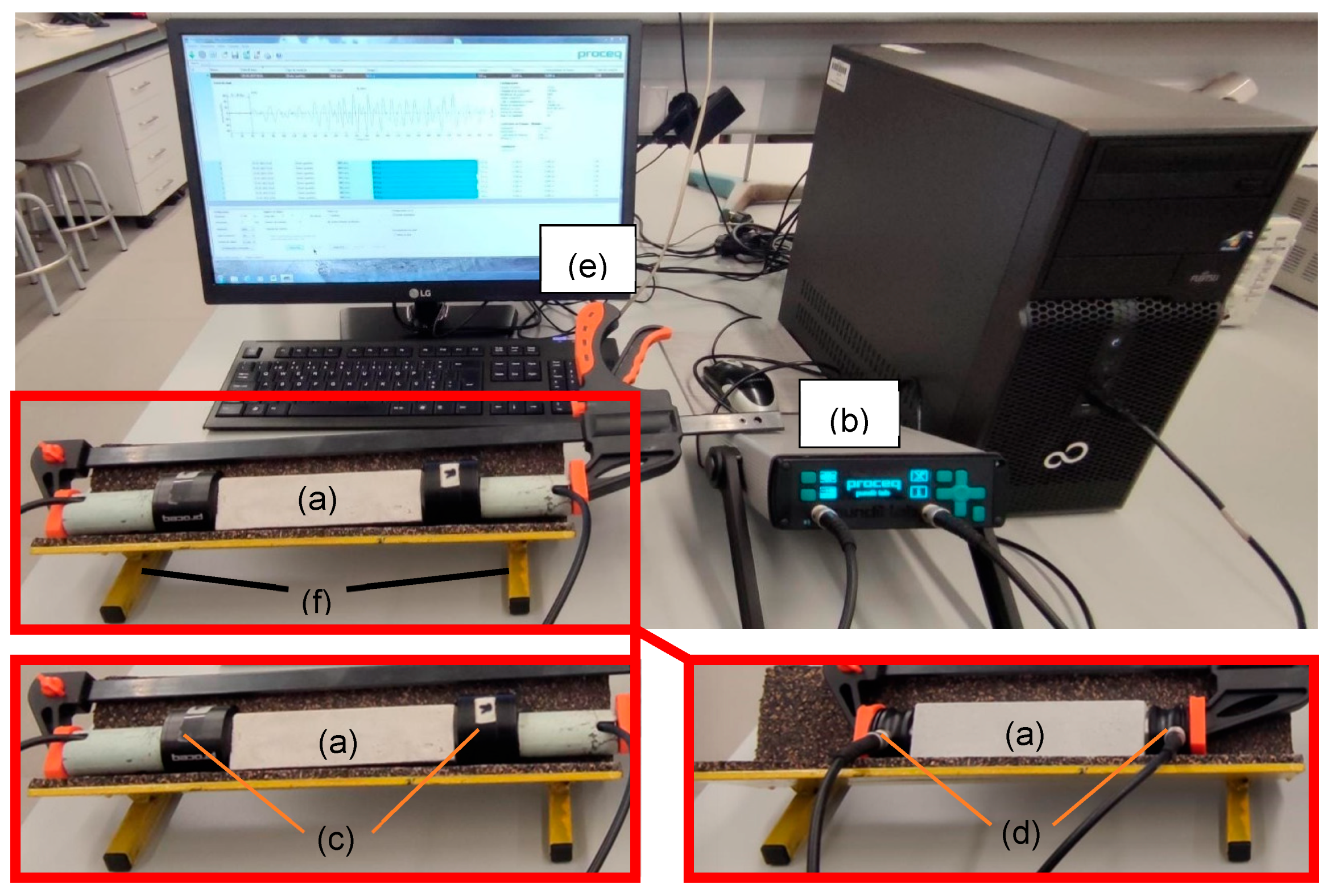
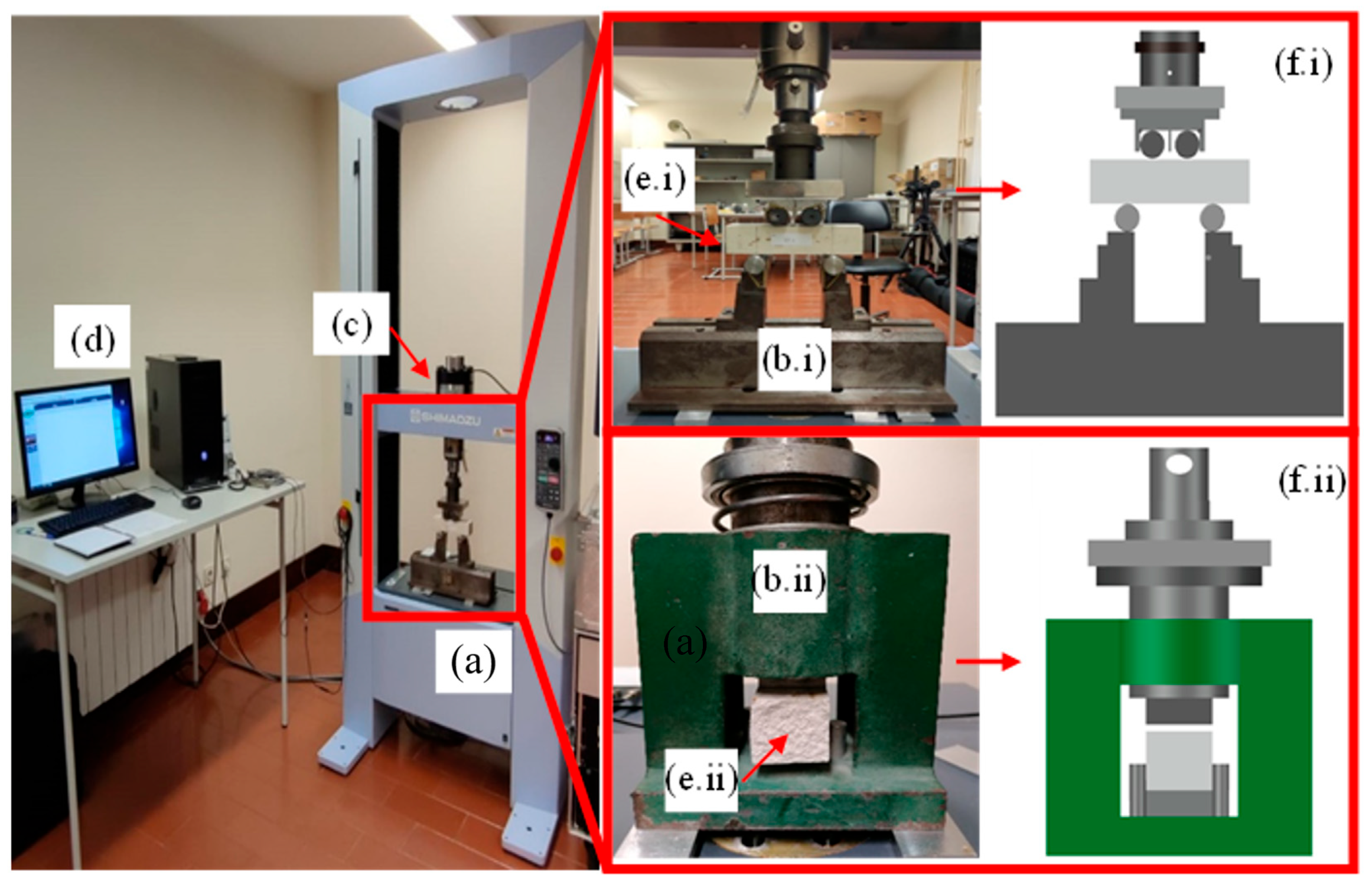

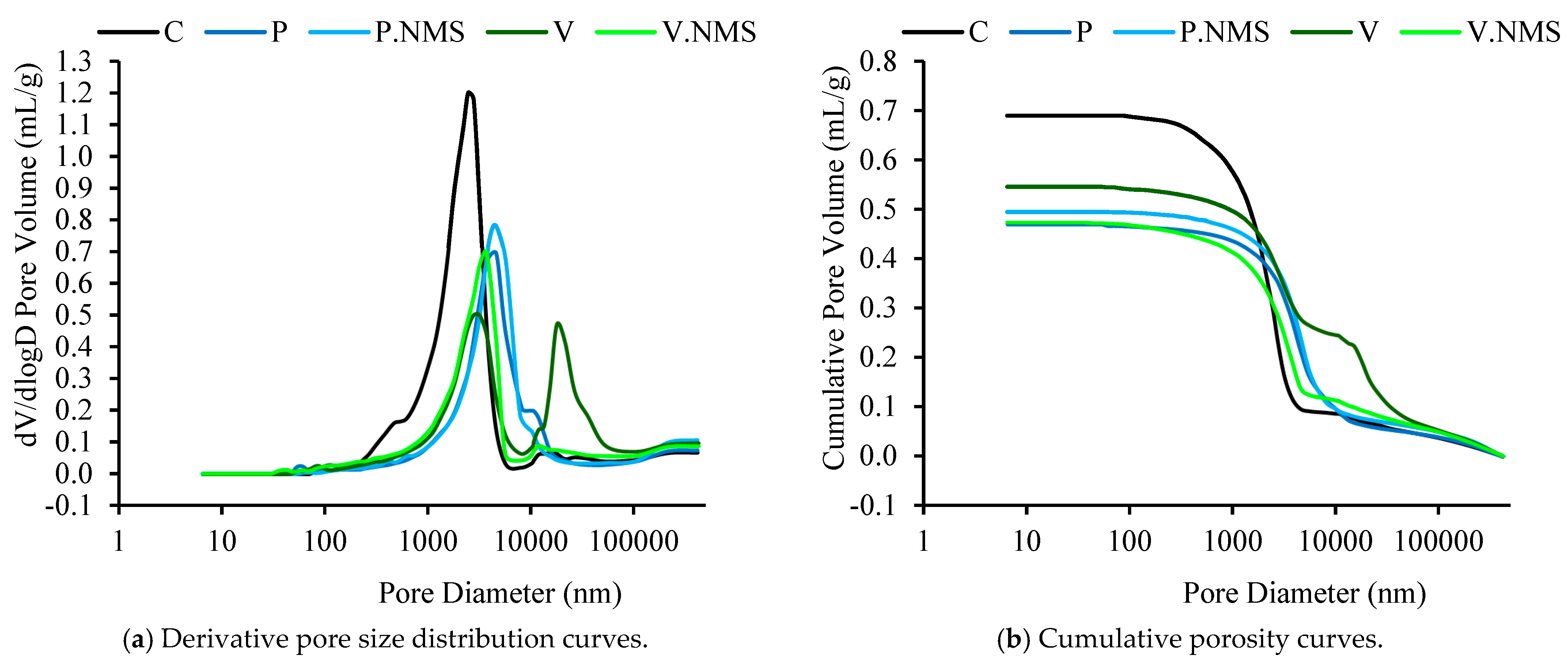
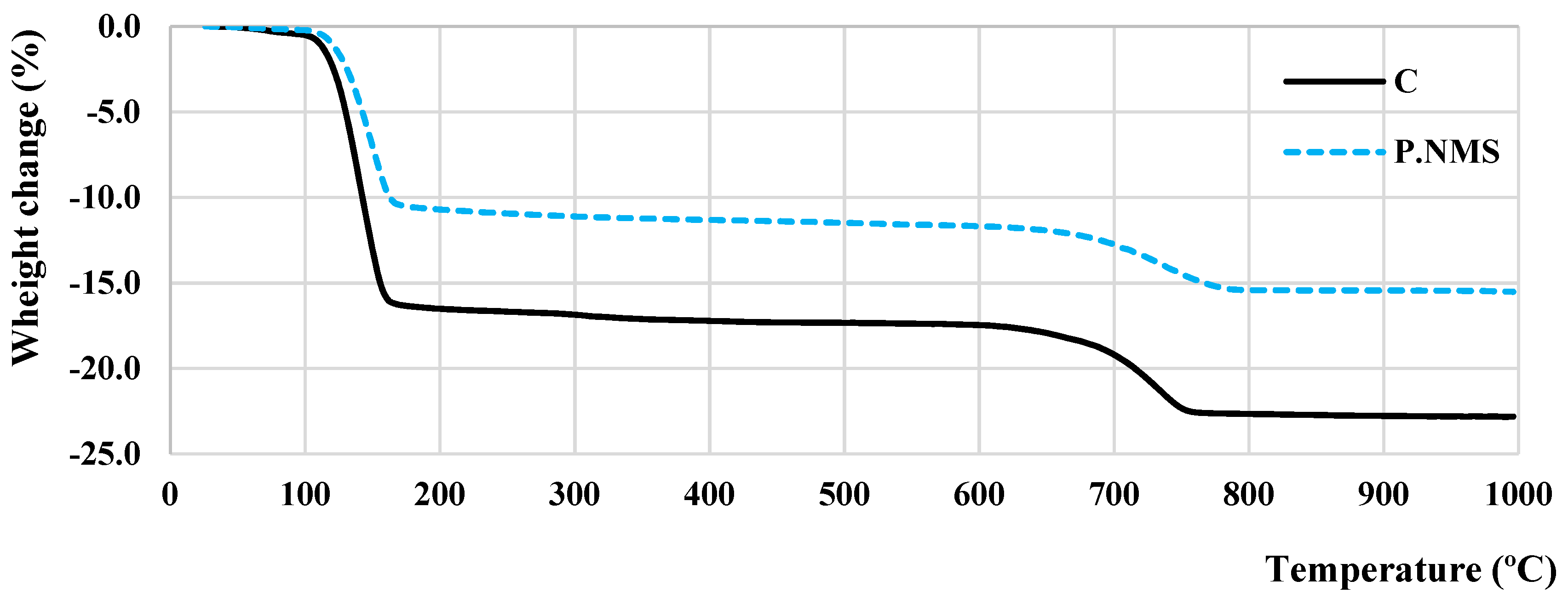
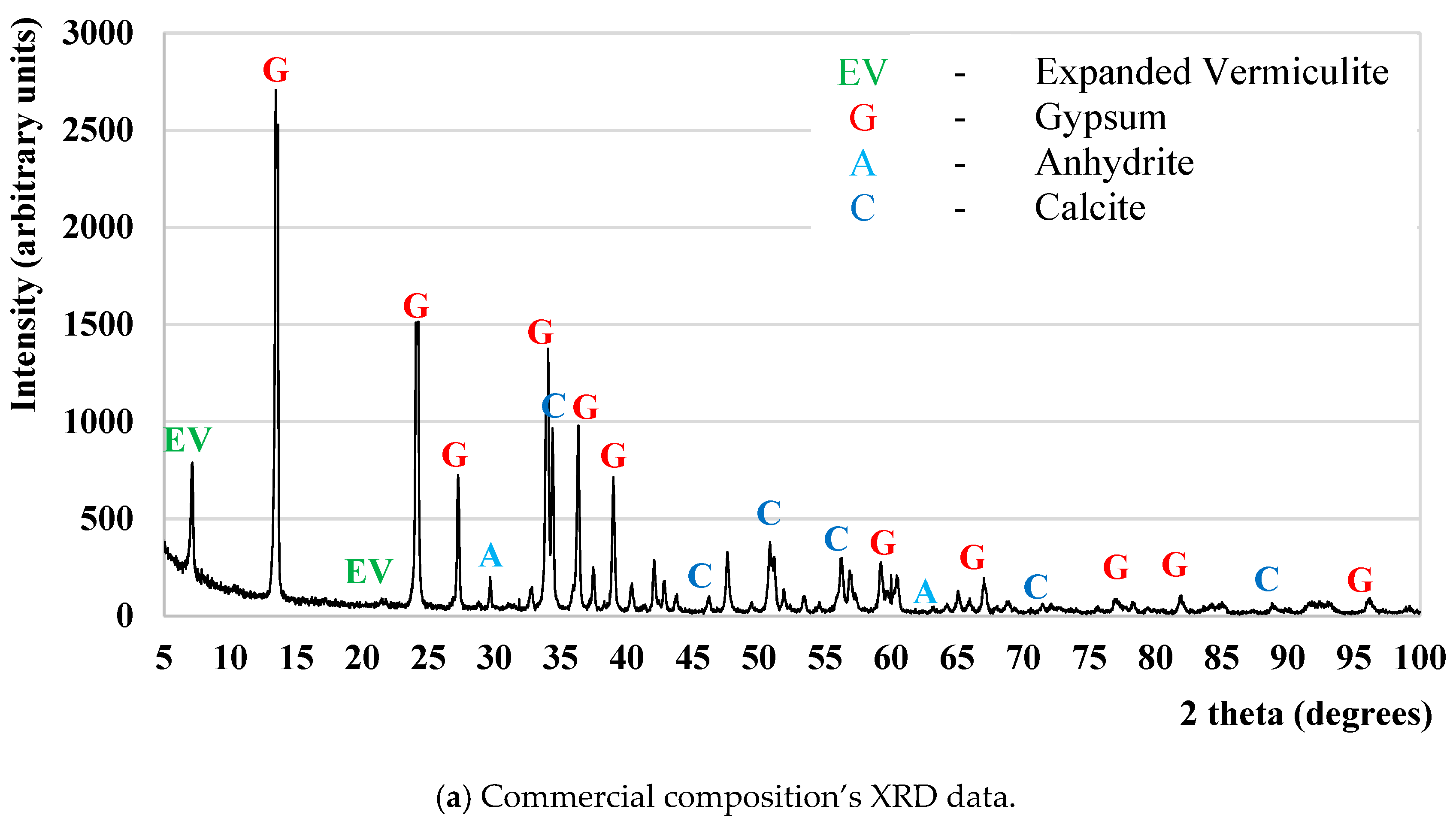
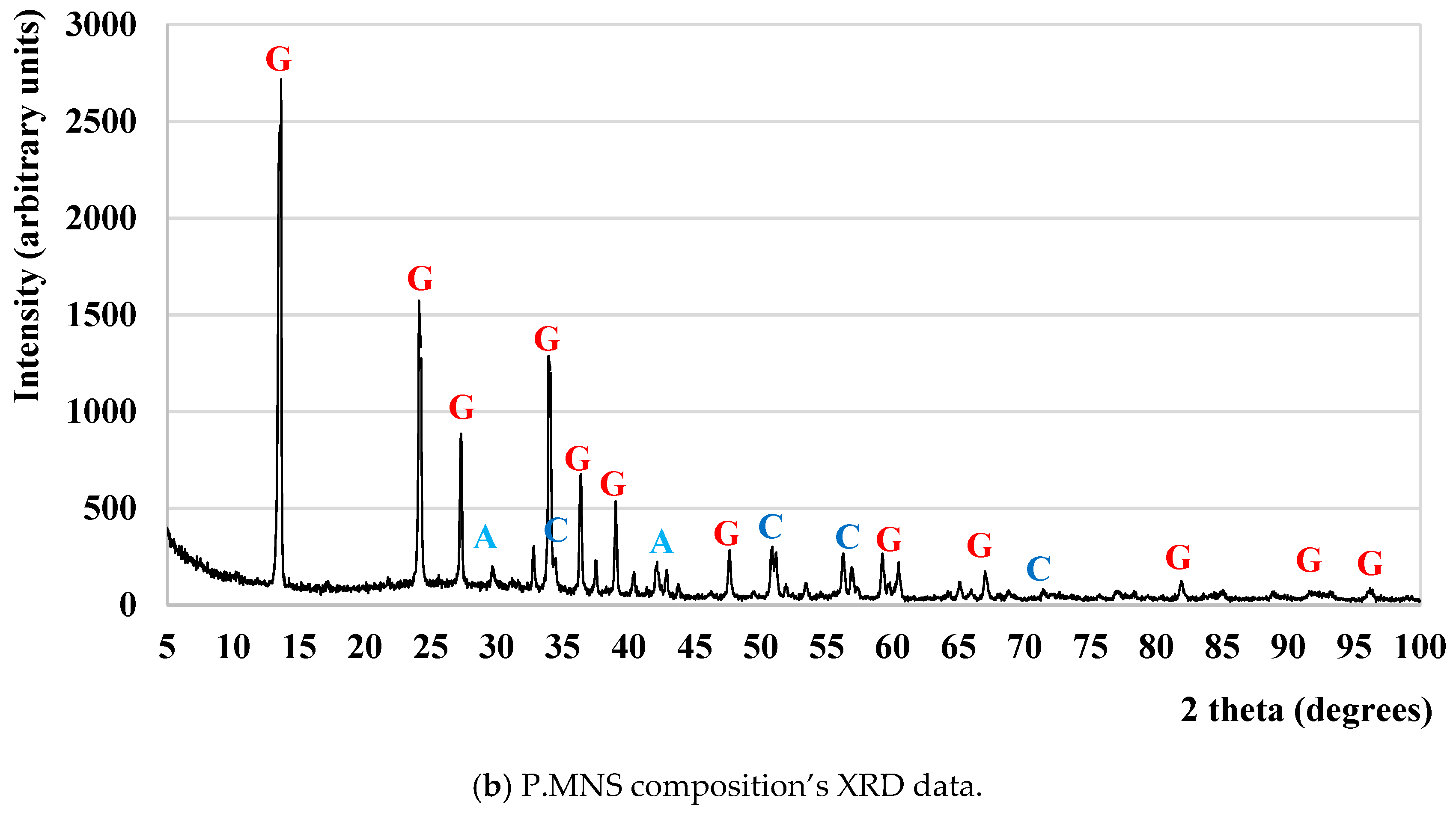
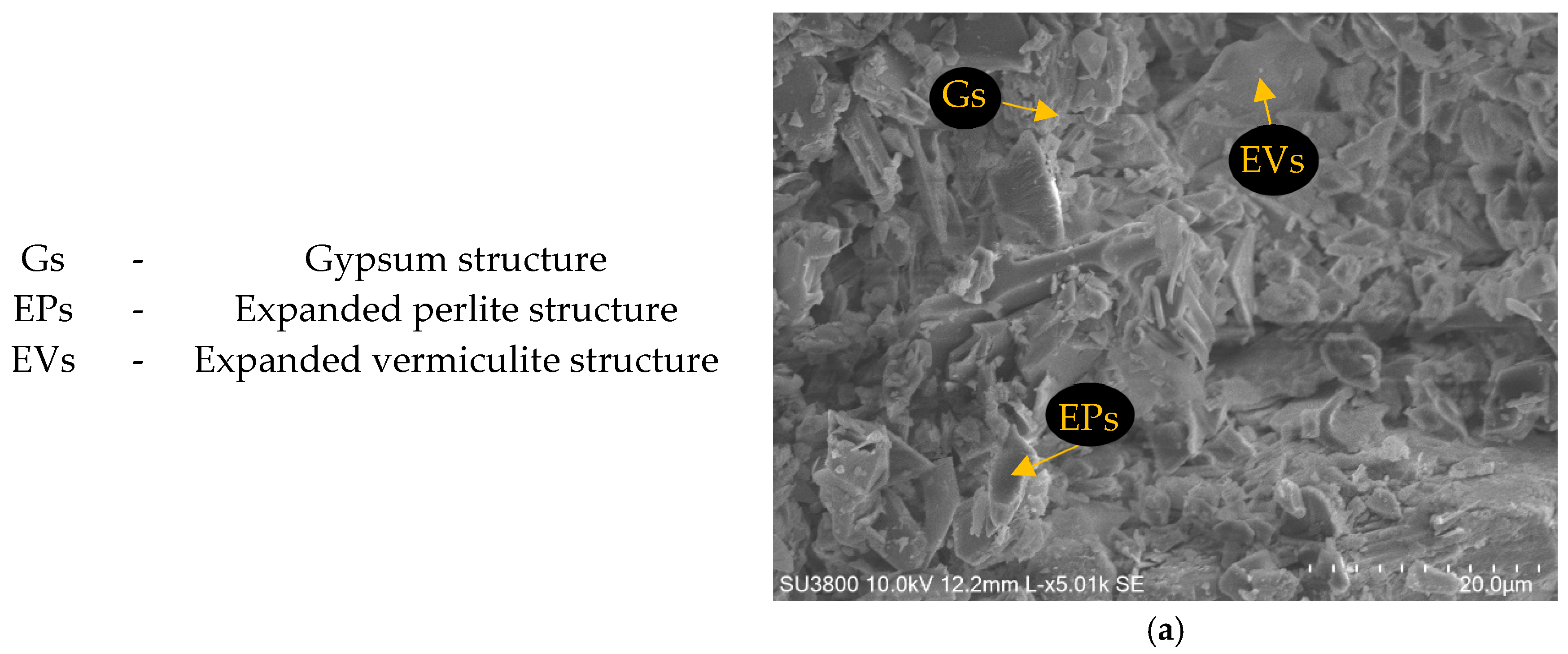
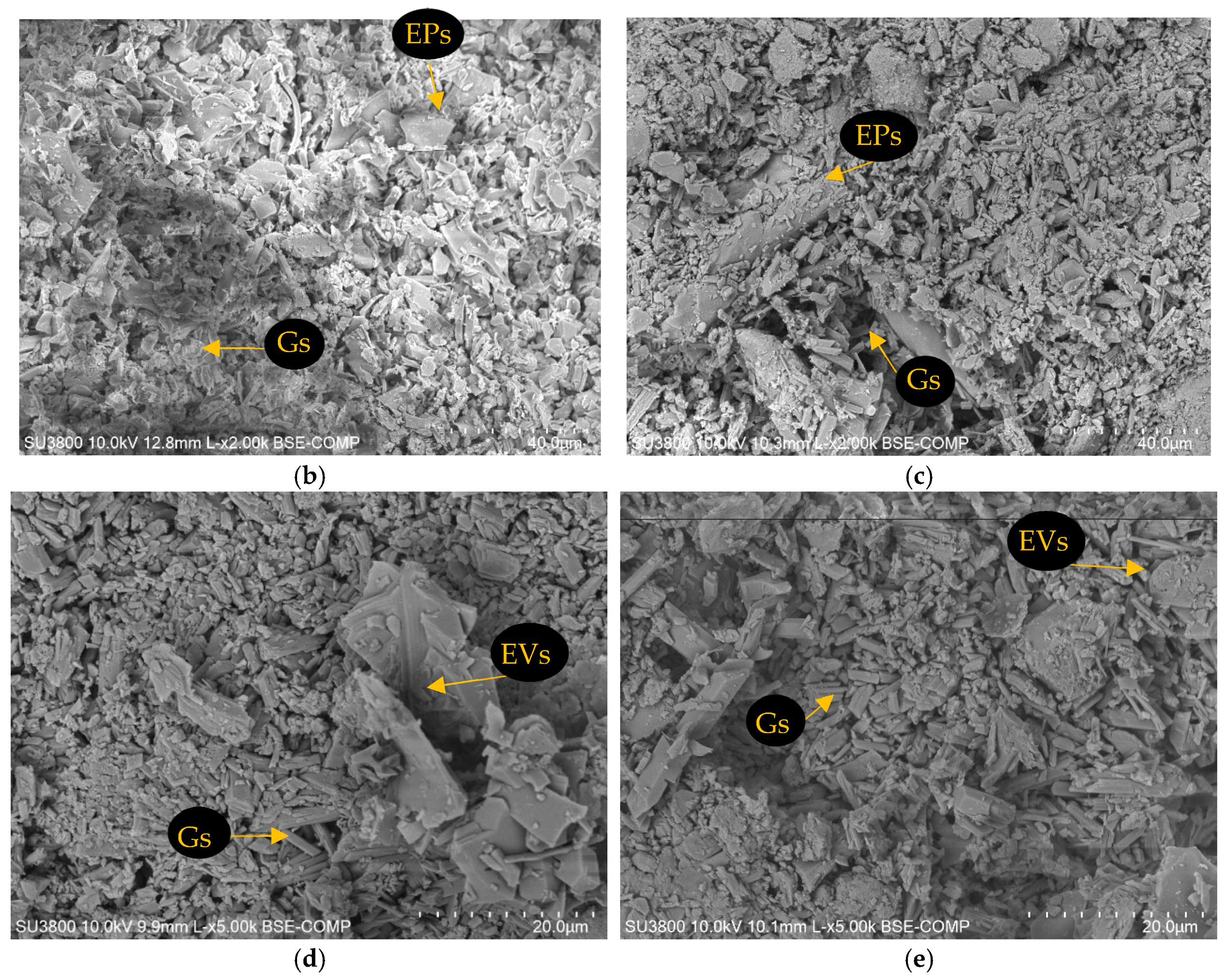
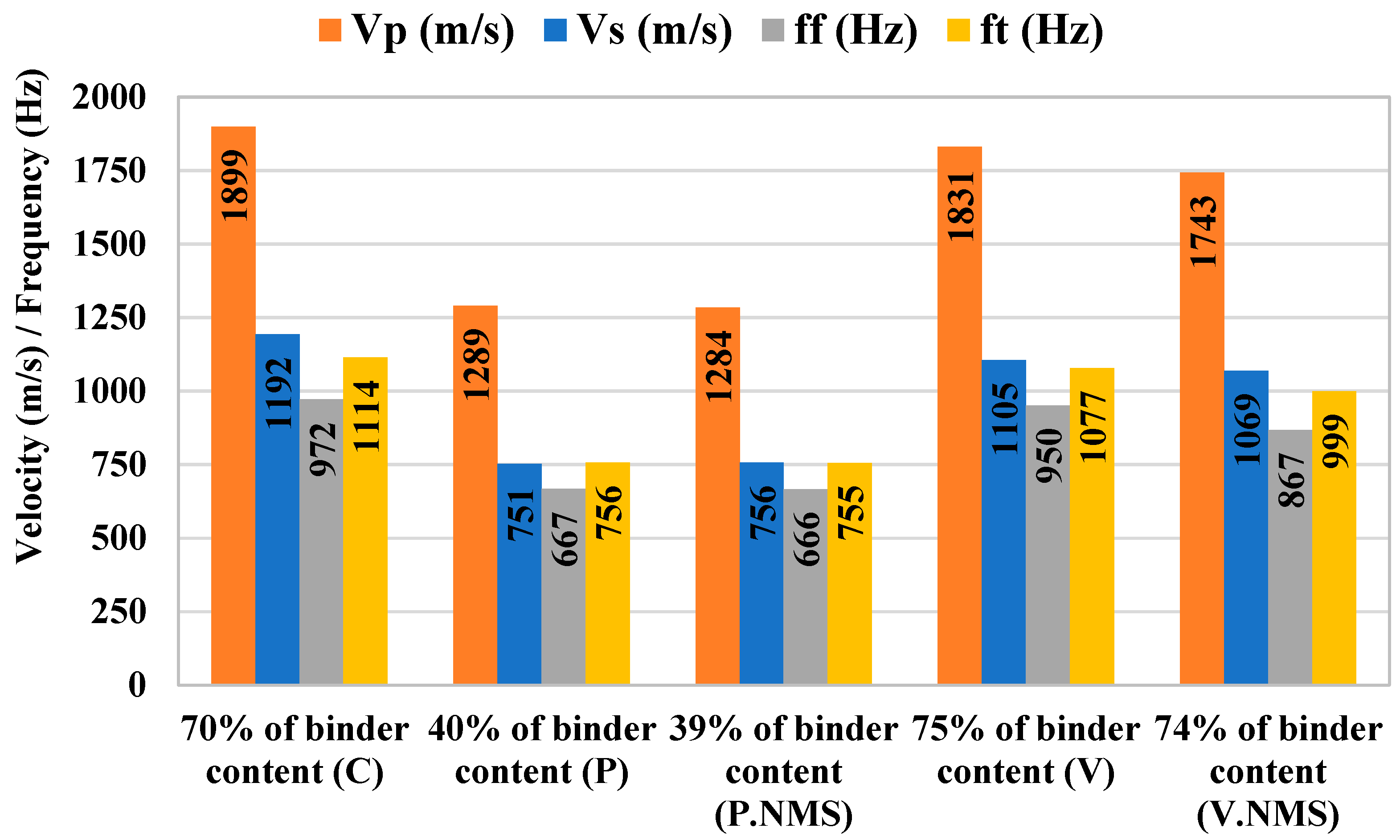
| Mortar Designation | CPPS | GP | EV | EP | NS and MS * | W/B ** |
|---|---|---|---|---|---|---|
| C | 100% | - | - | - | - | 0.60 |
| P | - | 40% | - | 60% | - | 1.08 |
| P.NMS | - | 39% | - | 60% | 1% | 1.04 |
| V | - | 90% | 10% | - | - | 0.70 |
| V.NMS | - | 89% | 10% | - | 1% | 0.66 |
| Mortar Designation | Vp (m/s) | Vs (m/s) | E (GPa) | G (GPa) | Μ |
|---|---|---|---|---|---|
| C | 1899 | 1192 | 2.656 | 1.130 | 0.18 |
| P | 1289 | 751 | 1.192 | 0.488 | 0.23 |
| P.NMS | 1284 | 756 | 1.212 | 0.491 | 0.23 |
| V | 1831 | 1105 | 2.913 | 1.217 | 0.21 |
| V.NMS | 1743 | 1069 | 2.674 | 1.116 | 0.20 |
| Mortar Designation | ff (Hz) | ft (Hz) | E (GPa) | G (GPa) | μ |
|---|---|---|---|---|---|
| C | 972 | 1114 | 2.601 | 1.091 | 0.19 |
| P | 667 | 756 | 1.381 | 0.564 | 0.22 |
| P.NMS | 666 | 755 | 1.293 | 0.533 | 0.21 |
| V | 950 | 1077 | 2.721 | 1.111 | 0.22 |
| V.NMS | 867 | 999 | 2.708 | 1.118 | 0.20 |
| Mortar Designation | E (GPa) | G (GPa) | μ |
|---|---|---|---|
| C | 2.629 | 1.111 | 0.18 |
| P | 1.286 | 0.526 | 0.23 |
| P.NMS | 1.253 | 0.512 | 0.22 |
| V | 2.817 | 1.164 | 0.22 |
| V.NMS | 2.691 | 1.117 | 0.20 |
| Mortar Designation | UPV’s E Ratios (%) | IEV’s E Ratios (%) | UPV’s G Ratios (%) | IEV’s G Ratios (%) |
|---|---|---|---|---|
| C | - | - | - | - |
| P | 44.9 | 53.1 | 43.2 | 51.7 |
| P.NMS | 45.6 | 49.7 | 43.5 | 48.9 |
| V | 109.7 | 104.6 | 107.7 | 101.8 |
| V.NMS | 100.7 | 104.1 | 98.8 | 102.5 |
| Specimen Designation | Maximum Load (N) | Average Load (N) | fct,fl (MPa) | SD |
|---|---|---|---|---|
| C.1 | 984.0 | 939.4 | 1.945 | 0.066 |
| C.2 | 922.9 | |||
| C.3 | 911.3 | |||
| P.1 | 445.4 | 461.3 | 0.955 | 0.028 |
| P.2 | 478.1 | |||
| P.3 | 460.4 | |||
| P.NMS.1 | 404.1 | 419.5 | 0.868 | 0.038 |
| P.NMS.2 | 445.6 | |||
| P.NMS.3 | 408.9 | |||
| V.1 | 1065.4 | 1057.5 | 2.189 | 0.015 |
| V.2 | 1047.7 | |||
| V.3 | 1059.3 | |||
| V.NMS.1 | 979.1 | 969.8 | 2.008 | 0.017 |
| V.NMS.2 | 971.4 | |||
| V.NMS.3 | 959.0 |
| Specimen Designation | Maximum Load (N) | Average Load (N) | fct,c (MPa) | SD |
|---|---|---|---|---|
| C.1.1 | 5259.0 | 5275.2 | 3.297 | 0.013 |
| C.1.2 | 5306.1 | |||
| C.2.1 | 5260.5 | |||
| P.1.1 | 1628.0 | 1636.6 | 1.023 | 0.034 |
| P.1.1 | 1575.4 | |||
| P.2.1 | 1706.4 | |||
| P.NMS.1.1 | 1833.9 | 1775.9 | 1.110 | 0.050 |
| P.NMS.1.2 | 1711.7 | |||
| P.NMS.2.1 | 1782.1 | |||
| V.1.1 | 5040.3 | 5007.5 | 3.139 | 0.031 |
| V.1.2 | 4937.9 | |||
| V.2.1 | 5044.3 | |||
| V.NMS.1.1 | 4387.8 | 4427.5 | 2.767 | 0.091 |
| V.NMS.1.2 | 4552.7 | |||
| V.NMS.2.1 | 4341.9 |
| Mortar Designation | Flexural Strength (MPa) | Flexural Strength Versus C’s (%) | Compression Strength (MPa) | Compression Strength Versus C’s (%) |
|---|---|---|---|---|
| C | 1.945 | - | 3.297 | - |
| P | 0.955 | 49.1 | 1.023 | 31.0 |
| P.NMS | 0.868 | 44.6 | 1.110 | 33.7 |
| V | 2.189 | 112.5 | 3.139 | 95.2 |
| V.NMS | 2.008 | 103.2 | 2.767 | 83.9 |
Disclaimer/Publisher’s Note: The statements, opinions and data contained in all publications are solely those of the individual author(s) and contributor(s) and not of MDPI and/or the editor(s). MDPI and/or the editor(s) disclaim responsibility for any injury to people or property resulting from any ideas, methods, instructions or products referred to in the content. |
© 2024 by the authors. Licensee MDPI, Basel, Switzerland. This article is an open access article distributed under the terms and conditions of the Creative Commons Attribution (CC BY) license (https://creativecommons.org/licenses/by/4.0/).
Share and Cite
Caetano, H.; Vilhena, L.; Ramalho, A.; Santiago, A.; Laím, L.; Monteiro, E. Mechanical Characterisation of Gypsum-Based Passive Fire Protection Mortars with Micro and Nano Silica Particles. Appl. Sci. 2024, 14, 8612. https://doi.org/10.3390/app14198612
Caetano H, Vilhena L, Ramalho A, Santiago A, Laím L, Monteiro E. Mechanical Characterisation of Gypsum-Based Passive Fire Protection Mortars with Micro and Nano Silica Particles. Applied Sciences. 2024; 14(19):8612. https://doi.org/10.3390/app14198612
Chicago/Turabian StyleCaetano, Hugo, Luís Vilhena, Amílcar Ramalho, Aldina Santiago, Luís Laím, and Eduardo Monteiro. 2024. "Mechanical Characterisation of Gypsum-Based Passive Fire Protection Mortars with Micro and Nano Silica Particles" Applied Sciences 14, no. 19: 8612. https://doi.org/10.3390/app14198612










